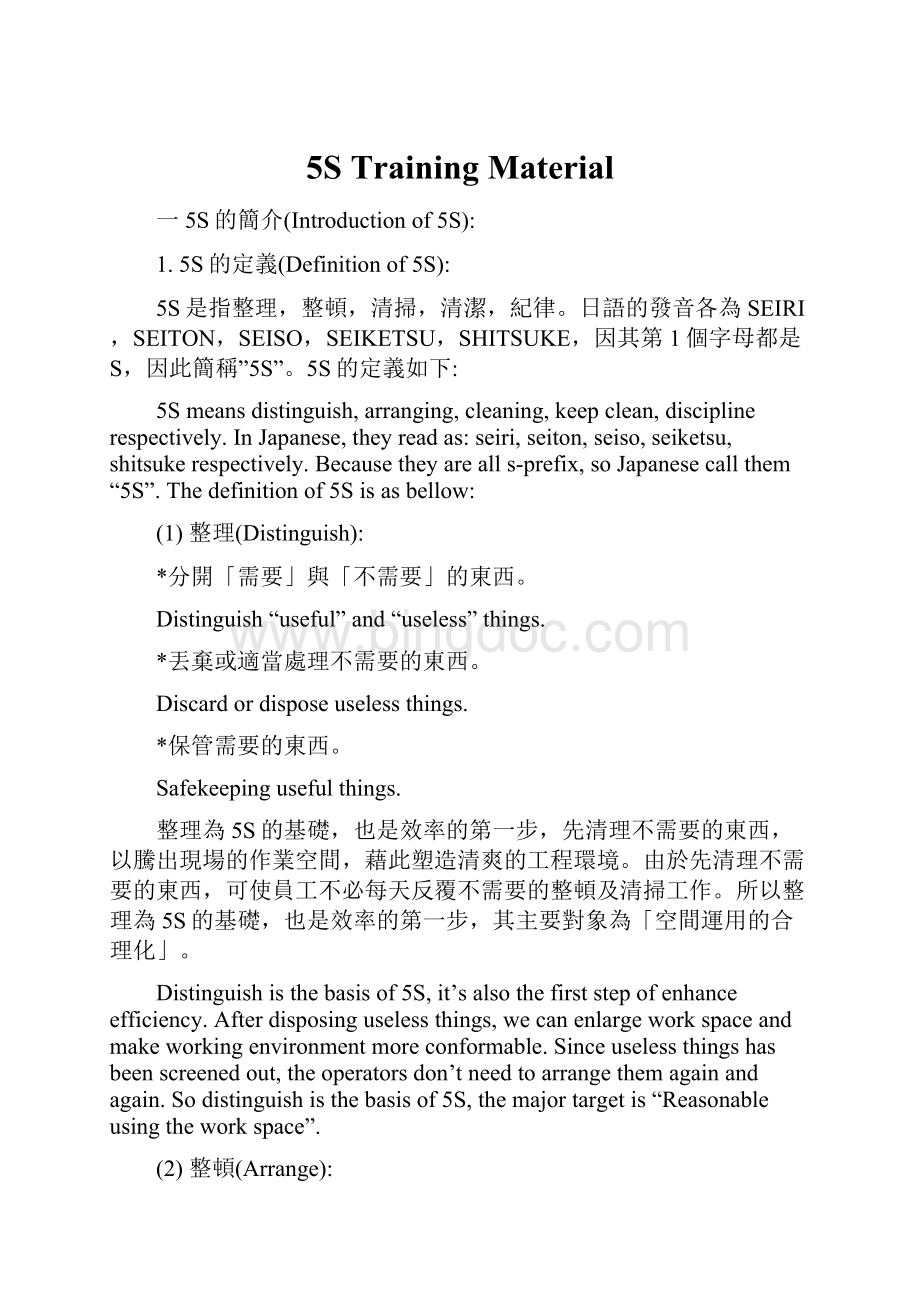5STraining Material.docx
《5STraining Material.docx》由会员分享,可在线阅读,更多相关《5STraining Material.docx(13页珍藏版)》请在冰点文库上搜索。

5STrainingMaterial
一5S的簡介(Introductionof5S):
1.5S的定義(Definitionof5S):
5S是指整理,整頓,清掃,清潔,紀律。
日語的發音各為SEIRI,SEITON,SEISO,SEIKETSU,SHITSUKE,因其第1個字母都是S,因此簡稱”5S”。
5S的定義如下:
5Smeansdistinguish,arranging,cleaning,keepclean,disciplinerespectively.InJapanese,theyreadas:
seiri,seiton,seiso,seiketsu,shitsukerespectively.Becausetheyarealls-prefix,soJapanesecallthem“5S”.Thedefinitionof5Sisasbellow:
(1)整理(Distinguish):
*分開「需要」與「不需要」的東西。
Distinguish“useful”and“useless”things.
*丟棄或適當處理不需要的東西。
Discardordisposeuselessthings.
*保管需要的東西。
Safekeepingusefulthings.
整理為5S的基礎,也是效率的第一步,先清理不需要的東西,以騰出現場的作業空間,藉此塑造清爽的工程環境。
由於先清理不需要的東西,可使員工不必每天反覆不需要的整頓及清掃工作。
所以整理為5S的基礎,也是效率的第一步,其主要對象為「空間運用的合理化」。
Distinguishisthebasisof5S,it’salsothefirststepofenhanceefficiency.Afterdisposinguselessthings,wecanenlargeworkspaceandmakeworkingenvironmentmoreconformable.Sinceuselessthingshasbeenscreenedout,theoperatorsdon’tneedtoarrangethemagainandagain.Sodistinguishisthebasisof5S,themajortargetis“Reasonableusingtheworkspace”.
(2)整頓(Arrange):
*將東西定位。
Putthingsinspecificlocation.
*將東西標示。
Markingthethings.
*將東西歸位。
Putthingsintherightlocation.
整頓為東西放置的標準化,使人員在需要的時候,可以很快找到所需要的東西。
整頓亦透過「看板」及「標示」的目視管理,如同超級市場一樣,不管是誰都能很快找到自己想要的東西。
因此,整頓的最終目的為創造「一目了然的工作環境」,其主要對象為「縮短物品的尋找時間」。
Arrangementmeanstostandardizestoragelocationofthings,itwillleteveryonefindanythingwhichtheyneed.Thereare2kindsoftoolscanbeusedtoarrangethings:
“kan-ban”and“marking”,it’sjustlikeinsupermarket,anyonecanfindtheywantbylooking“kan-ban”and“marking”.Sothemajortargetofarrangeis“Createaclearworkingenvironment”,then“shortenthetimeoflookingforthings”.
(3)清掃(Clean):
*消除污垢。
Eliminatedirty.
*自主保養的第一步。
Preventivemaintain.
員工透過清掃的行為,以早期發現設備的異音,異溫,鬆動…等,而達到全面生產保養的目的。
因此,清掃的最終目的為創造「高稼動率的工作場所」,其主要對象為「保持環境整潔及設備的高可靠度」。
Thoughthecleaning,wecanfindpreliminarydeviationofmachine.Thiswillletusfinishthetargetof“totalpreventivemaintenance”.Sothemajortargetofcleaningis“Createhighefficientworkingenvironment”,then“Keepenvironmentcleanandwithhighreliability”.
(4)清潔(Keepclean):
*維持整理,整頓,清掃的既有水準。
Keeptheeffectof“distinguish”,“arrange”,and“clean”.
*根絕髒亂源頭。
Eradicatetherootcauseofdirty.
徹查髒亂發生的源頭,並加以改善。
例如在發現設備有異音,異溫,鬆動…等現象時,即應找出異常之原因及預防再發的方法。
因此,清潔應有追根究底的科學精神,其最終目的為創造「明朗的工作場所」。
Findtherootcauseofdirtyandimproveit.Forexample,ifsomeonefindanydeviationformachine,heshouldfindouttherootcauseandtakeinpreventiveaction.So“keepclean”means“sciencemindforsolvingproblem”,and“tocreateaclearworkingenvironment”.
(5)紀律(Discipline):
*養成守法精神。
Toobeytherule.
*養成習慣。
Make“obeyrule”toacustom.
透過不斷的教育訓練,獎勵措施及考核方式,使人員養成作業習慣。
如此才能將良好的工作方式持續推展。
待人員習慣於良好的作業習慣後,無論對產品品質或效率提升皆有很大的幫助。
Thoughcontinuoustraining,award,andaudittoformahabit.Letthegoodideacanbeperformedforlongterm.Ifeveryonecangetusedtothehabit,thequalityproductivityandefficiencywillbegreatlyenhanced.
25S可以節省生產成本嗎?
(Can5Sreduceproductioncost?
)
在豐田生產方式中,指出生產現場的7項浪費如下:
Thereare7typesofwasteinTOYOTAproductionmethod:
*製造過多的浪費。
Manufacturetoomany.
*待工待料的浪費。
Waitformaterialormachine.
*搬運的浪費。
Transportation.
*加工本身的浪費。
Unnecessarymachining.
*庫存的浪費。
Stock.
*動作的浪費。
Unnecessarymotion.
*製造不良的浪費。
Defectiveproduct.
藉由5S的執行,對上述浪費的改善關係如下圖所示:
Therelationshipbetween5Sandwasteisasbelowtable:
整理
Distinguish
整頓
Arranging
清掃
Clean
清潔
Keepclean
紀律
Discipline
製造過多
Manufacturetoomany.
◎
待工待料
Waitformaterialormachine.
◎
◎
◎
搬運
Transportation.
◎
◎
◎
加工
Unnecessarymachining.
◎
庫存
Stock.
◎
動作的浪費
Unnecessarymotion
◎
◎
製造不良
Defectiveproduct.
◎
◎
◎
35S的其他效益
四5S的實施工具—紅牌作戰
所謂的紅牌即是指紅色標籤或紙張,主要用於標示現場待整頓之物品。
紅色標籤可使用於以下三類對象:
Redsheetmeansthatlabelorpaperinred,themajorfunctionistomarkthingswhichshouldbearranged.Redsheetisappliedto3itemsasbelow:
1.庫存品:
材料,半成品,配件,成品。
Stock:
material,workinprocess,parts,finishgood.
2.機器設備:
生產設備,維修工具,維修備品。
Equipment:
machine,tool,spareparts.
3.空間:
地區,通道,架子。
Space:
area,aisle,cabinet.
紅牌之決定基準可參照以下之標準:
Thefollowing3conditionsshouldbepurgedbyredsheet.
1.超出期限者:
滯存原料,滯銷成品。
Obsoletevaliddate:
Idlematerial,idlefinishgoods.
2.物品變質者:
氧化,變質,受潮導致影響產品品質者。
Deterioration:
Materialwhichoxidized,deteriorated,wetted.
3.物品可疑者:
雖經數次活動,但物品仍保持原狀,未有使用跡象者。
Skepticalthings:
Thethingremainsoriginalstatusafterseveraltimesofactivities.
五導入5S之步驟
*步驟一:
導入前之教育-以各部門主管及生產線領班為訓練種子,講授有關5S之定義及其必要性,以獲得共識與支持。
*Step1:
Trainingbeforeimplementation–Trainseedswhoaredepartmentheadsandshiftleadersabout5Sdefinitionandwhytoimplement5S.
*步驟二:
確立5S推行體制-成立委員會,透過組織的力量整合人力與資源,以使全員參加,藉此使活動活潑化及持續化。
Organizepromotioncommittee–Recruitstaffmembertointegratemanpowerandresource.Makesureallpeoplejointhisactivityandkeepthisactivitycontinued.
*步驟三:
擬定5S推行計畫:
包含年度活動計畫,預算及活動辦法。
Draft5Simplementationplan:
Itincludesannualplan,budgetandimplementingmethod.
*步驟四:
公司內啟蒙教育:
以全體員工為對象,由內部種子人員進行傳達教育,負責講授5S之定義,推行要領等。
Step4:
Overalltraining–Trainingallemployeeincompany.Seedsareteacherswhopromote5Sdefinition,spriteandinstructtheimplementingmethod.
*步驟五:
正式發動。
Step5:
Implementation.
*步驟六:
5S之評比及持續推行。
Step6:
Evaluationandauditfor5S.
附件一紅牌圖例(RedSheet)
品名(Description):
料號(P/N):
數量(Q’ty):
類別(Category):
1.原物料(Material)4.機械設備,備品(Machine,Parts)
2.在製品(WIP)5.治具,工具(Tools)
3.成品(FinishGoods)6.其他(Others)
待處理原因(Reasonfordisposition):
1.不需要(Useless)4.不明品(Dubious)
2.不良品(Failparts)5.其他(Others)
3.呆料(Idlematerial)
處理部門(ResponsibleDepartment):
處理方式(Disposition):
1.丟棄(Discard)3.別的保管方式(Othersafekeepingmethod)
2.移動至紅牌放置場(Movetospecificplace)4.其他(Others)
附件二5S稽核表
稽核地點(Placeofaudit):
Category
No.
AuditItem
是
否
備註
整理
(Distinguish)
1
要/不要的東西是否區分?
Separateuseful/unusefulparts.
2
不要的東西是否已清除?
Cleantheunusefulparts.
3
不要的東西是否置於規定處?
Unusefulpartsshouldbeputinspecificarea.
4
工作現場是否保持整潔?
Workareashouldkeepclean.
整頓
(Putthinginorder)
5
物品品名是否標示清楚?
Partsnameshouldbeshow.
6
物品數量是否標示清楚?
PartsQ’tyshouldbeshow.
7
工作現場的物品是否定位整齊?
Allofthepartsinworkareashouldbeputinrightlocation.
8
斑馬線之貼附是否完整?
Zebratapeshouldbestuckonthegroundcompletely.
清掃
(Clean)
9
地面上是否保持清潔?
Keepfloorclean.
10
機器設備是否保持清潔?
Keepmachineclean.
11
工作檯面是否保持清潔?
Keepworkplateclean.
12
是否定期清掃點檢設備?
Cleanandcheckmachinesperiodically.
清潔
(Keepclean)
13
機器設備是否定期保養?
Maintainmachinesperiodically.
14
保養後之機器設備是否確實乾淨?
Machinesisreallycleanaftermaintain.
15
相同之髒亂是否連續兩天發生?
Samecontaminationhappenedincontinuous2days.
16
工作服是否保持整潔?
KeeptheESDclothclean.
紀律
(Discipline)
17
產品是否依照規範及程序生產?
Followspecificationandproceduretomakeproducts.
18
作業時是否遵行ESD之規定?
FollowESDspecificationtowork.
19
工作現場是否皆穿靜電服?
WearESDclothtowrok.
20
工作時是否不聊天?
Nochattinginwork.
稽核者(Auditor):
日期(Date):
班別(Shift):